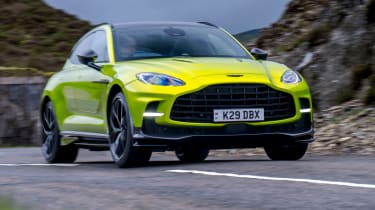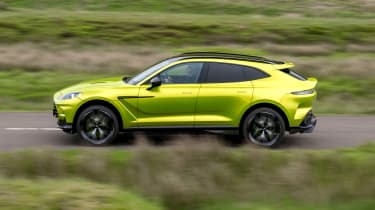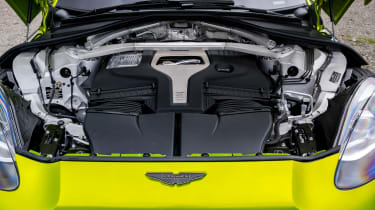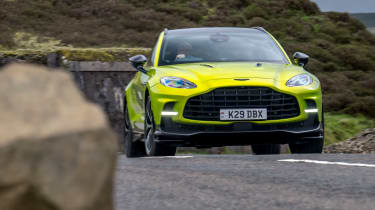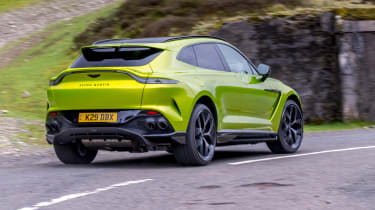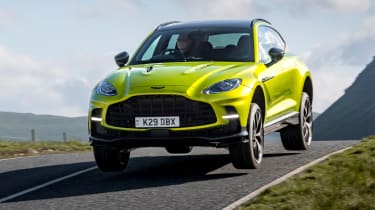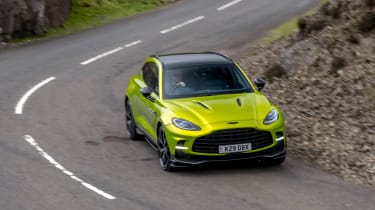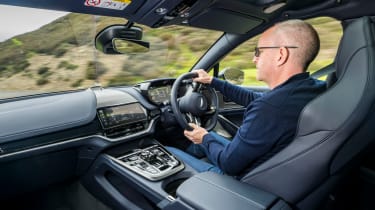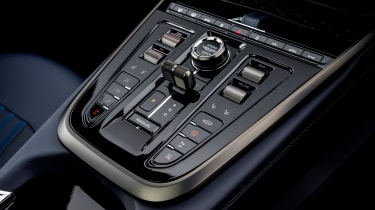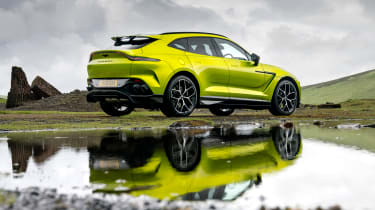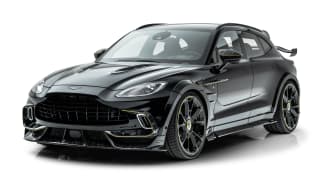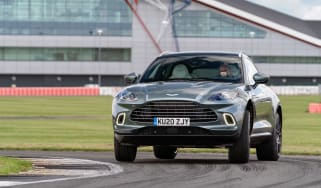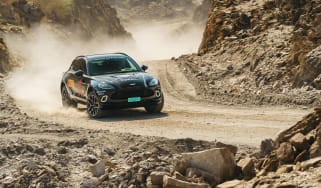Aston Martin DBX707 review – one of the best super SUVs on sale
A refreshed interior gives Aston Martin’s DBX707 a much needed lift in quality and functionality. Everything else stays the same, which is a good thing
Any thoughts that the high-performance SUV was going to be a victim of the great EV switch over are pretty far off the mark for the moment. Aston Martin’s DBX707 leads a cohort that includes the new Range Rover Sport SV, an updated Mercedes-AMG G63 another and the hybridised 789bhp Lamborghini Urus SE, alongside the latest Porsche Cayenne Turbo. BMW even tasked its M division to create a bespoke V8-powered SUV, the XM, but the less said about that the better.
Just as many of Aston’s rivals need their SUVs (maybe not BMW and the XM), so the British marque needs the DBX, and needs to offer more than one flavour of it. So now long after the standard DBX was been put out to pasture and now the DBX S has arrived to lead the pack, the DBX707 is technically the ‘base’ version of Aston’s SUV. The DBX707’s task is being none other than Aston Martin’s cash cow.
Extra publicity to that end has come from it being roped into the Formula 1 circus over the last couple of years as the official medical car, building on the strengths of the previous DBX medical car with the added performance and track-focus to try keep up with the AMG safety car ahead of it.
There was much to be impressed by with the regular V8 DBX, specifically that it conducted itself on the road in a manner more in keeping with a supersaloon than an SUV. This was due to a dynamic set-up that doesn’t bludgeon the road and a performance delivery that’s more sniper than blunderbuss. It’s also a car that any sane individual wouldn’t step away from wishing it had nearly 30 per cent more power, or the ability to crack 197mph or reach 60mph in 3.1 seconds.
More reviews
Long term tests
Review
Reviews
> Aston Martin DBX707 v Ferrari Purosangue – flagship super SUVs go head-to-head
After running one on evo’s Fast Fleet for 12,000 miles neither did we think it needed to be stiffer, more aerodynamically efficient or have a larger tyre footprint. Unlike Aston Martin, who clearly did and therefore has given it all of the above. But rather than eradicating all that is good about the regular DBX in the process, it’s turned the car we shouldn’t rate so highly, but do, into one that we have an even higher opinion of.
Engine, gearbox and technical highlights
The DBX707 does bring significant changes to the party. Aston Martin has stiffened the top mounts by 55 per cent, stiffened the body by nine per cent and increased electronic anti-roll bar torque by 50 per cent. There are changes to the three-chamber air suspension system, with the damper rates adjusted across all driver modes from GT through to Sport + too, though the Terrain modes are left alone.
New hydrobushes dampen the forces taken from the front axle to keep the steering as calm as possible and also to manage the unsprung weight that’s inevitable when you fit 23-inch wheels and tyres along with the brakes – standard carbon-ceramics measuring 420mm front and 390mm rear – required to slow a 2245kg SUV with 697bhp. These were installed on the early launch cars of the original DBX but didn’t make production due to durability concerns. Now they’ve passed the test, so Aston has fitted them to the 707 and plans to roll them out across the other DBX models, too. Unsprung mass has been reduced by 40
Speaking of power and performance, AMG’s M177 4-litre twin-turbocharged V8, the engine found in all eight-cylinder Aston Martins and quite a few Mercedes-AMG products too, has bespoke specifications and hardware to produce its potency.
New ball-bearing turbochargers are fitted, there’s revised fuel and valve mapping and an exhaust system that’s new front to back, and the engine’s brain has had the mother of all reboots to get to that 697bhp, all yours at 6000rpm, with 664lb ft of torque delivered from 2600rpm through to 4500rpm – increases of 155bhp and 148lb ft over the V8 in the standard DBX.
While the automatic gearbox still has nine ratios, they are part of a new wet-clutch transmission that has also been through the Aston Martin gym to sharpen shift responses and maximise the potential of its shorter final drive ratio, while a recalibration to the software results in more torque going to the rear axle more of the time. The four-wheel-drive modes have been optimised to better suit the engine’s increased power and torque outputs, with the 707 rear-wheel drive until it feels the need to send torque to the front axle.
Aero upgrades go beyond the wider mouth to aid cooling. The front splitter helps reduce drag while keeping lift neutral, and alongside the front winglets also cools the monstrous carbon brakes so they maintain their well-modulated feel and retardation performance – pretty impressive for a car so big when driven up and over a quick mountain pass.
Those front winglets are also designed to reduce turbulence around the front wheels, while additions to the side sills and a vent in each rear quarter panel are designed to draw air through and away from the rears. Combined with a larger than expected rear diffuser, which also features its own secondary wing, and a carbon extension to the roof spoiler, the DBX certainly makes a statement over its regular siblings. The rear diffuser looks like it should have a ‘no step’ sign affixed to it.
For 2024 Aston upgraded the DBX707 again, with the new-generation interior from the Vantage and DB12 as well as their Bilstein DTX dampers. The steering in GT mode was recalibrated to provide more assistance when you push on and the suspension control unit modified to allow the systems to interact earlier and more seamlessly. And following requests from customers, under higher torque loads and at lower engine speeds (below 4000rpm) the exhaust note is more prominent.
Performance, ride and handling
Initial fears that the DBX’s smooth running would be turned brittle with the car’s stiffening take little time to be expunged, as the car’s inherent compliance and calmness are immediately evident. So too is the increased flattening of the body thanks to the revised electronic anti-roll-bar system.
Yet the ride is now more supple, forgiving and strangely more relaxing at low speed than its less powerful brother. The regular DBX is already pretty remarkable at how it manages its mass and centre of gravity, avoiding the trap that all but a few SUVs fall into of feeling like they’re of an old-school body-on-ladder-frame construction despite their thoroughly 21st-century platforms. It’s what gives the Aston its super-estate-car feel, and in the 707 it’s ratcheted up to a higher level still. Even on its new (optional) 23-inch wheels and tyres it takes a particularly nasty crevice in the tarmac to send a shudder through the body or cabin.
But a great deal of the higher levels of body control and ride quality can be attributed to the hydrobushes on the front suspension. It’s one of the most immediate transformations of the car, shutting down the low-speed patter to provide a genuine GT-esque ride quality.
Which is clever and essential stuff, because it’s likely that if you’re in the market to buy a £205,000, near-700bhp Aston Martin that seats five and covers tarmac without flinching, you’ll want a ride as cosseting as a Bentley’s, which it certainly has when compared with the Bentayga. The quiet-start function will be appreciated by neighbours in close proximity to 707 owners, but even in its loudest setting the tone has less of the bark and blare of old. At a push you might even call it cultured.
There isn’t a savage shove from this revised V8 that means it out-muscles the V12 Vantage – the SUV gives 76bhp in the power-to-weight battle to the sleek coupe – but there is more of an edge to throttle inputs, and while peak torque arrives 400rpm later and drops off 500rpm earlier than with the regular V8 DBX, there’s more of it arriving lower down, which makes the 707 a sharper, more responsive machine.
Turn the rotary mode dial to Sport or Sport+ and the V8 awakens like a poked bear, the revs taking huge swipes around the tacho, speed building at a rate that makes you grateful for the polish that’s been applied to the chassis and the linear response of a steering rack that appears to have forgotten it’s in control of an SUV and not one of Aston’s front-engined GTs.
There’s plenty of grip, as you’d expect from 275-wide front and 310-wide rear Pirelli P Zeros, but it doesn’t mask what’s going on, which makes positioning Aston’s answer to Porsche’s hottest Cayenne a more precise process. Settle into a rhythm and relax rather than trying to hustle the 707 and it flows with a more connected feel and sense of engagement than a non-Competition BMW M5 or an Audi RS6, feeling more organic and natural in how it drives rather than like it’s relying on technology to get it down the road.
The technology it does have at its disposal is complementary rather than interfering. The adjustments to the AWD system mean it drives out of corners with an unexpected poise rather than scrambling out on all fours and pawing at the surface. In quicker turns it feels balanced from the moment you turn in to the second you squeeze open the throttle, being as far removed from a point-and-squirt super-SUV as you can imagine. It’s a car that you admire more for its core competencies and capabilities than your self-consciousness tells you that you should.
With each passing mile the 707 impresses. As a purist you continue to look for flaws, of which there are some: it’s still a big car, no matter how tightly it wraps itself around you, and while it rides with exceptional quality at all speeds and feels precise and faithful through every twist and turn, your grey matter is always yelling at you that something that weighs two and quarter tons, is five metres long, nearly two metres wide and 1.7 metres high isn’t going to come out on top with physics if it starts to get a little out of hand. And when you’re pushing on, the active anti-roll bars sometimes exaggerate the car’s cornering flatness in and through a corner to the point of distraction, as if the tyres aren’t quite keyed into the surface.
It remains impressive that you feel in control of the 707, that it doesn’t set out to scare you or impress you just for the sake of it. There’s real depth to its development that’s very easy to experience and hard not to appreciate. It’s more rounded than Porsche’s Cayenne Turbo GT, although not as laser focused on outright performance, feeling content to sacrifice some thrills for a less tense approach to everything it does. And it knocks a Lamborghini Urus SE for six (can something be knocked for seven? If so, that’s the Lambo), making the Italian feel flatfooted and one dimensional.
As a GT the DBX still covers endless motorway miles in the relaxed and responsive way, providing a blend between a locked-down supersaloon and a luxury car that’s happy to breathe with the surface. On roads evo often finds itself on during eCoty and group tests it deals with the bucking, challenging topography with that inherent balance, communication and surefootedness the DBX has always portrayed. It remains the best of its type for those who enjoy driving and now it has a far nicer interior to enjoy the experience from.
Interior and tech
With the budget spent on the car’s bespoke platform, accompanying design, dynamics to give Porsche sleepless nights and a ‘new’ factory to build it in, when it came to dressing the inside of the DBX707 Aston Martin was shaking the last pennies from its investors’ piggy banks and was left with those small bits of fluff, a franc and a piece of Lego. Probably.
It meant the car charged with lifting the company from its post-IPO hangover had an interior that was, at best, functional, but in reality not as good as that. It simply wasn’t fitting for a car carrying the DBX’s price tag and competing with Range Rovers, Bentleys and other higher-end VW Group products. It’s why one of executive chairman Lawrence Stroll’s first instructions upon his arrival was to fix the interiors of the DBX and all other Astons. We saw the first of these in 2023’s DB12, the next more recently in the new Vantage and Vanquish, and then the DBX707 got the upgrade.
Perhaps it’s because the DBX isn’t new-new like the DB12 and Vantage that the makeover looks a far greater triumph. Where previously there were plain surfaces and scattered switchgear borrowed from Mercedes, there is now texture to the surfaces and jewellery for the controls. Those controls are also integrated rather than simply placed where they are required. There’s a blend of haptic buttons and knurled metal knobs and wheels. There’s a touchscreen with wireless Apple CarPlay with the same for Android to come via an over-the-air update. There are no more push buttons embedded in the dashboard for the gearbox controls; instead there’s a kind of gear lever on the transmission tunnel.
There’s more detail to the facia facings and the instrument cluster is a configurable TFT screen that’s integrated into the dash-top rather than simply plonked there. There’s more personalisation for trims and finishes than before, too, allowing you to create something truly bespoke. It’s a cabin worthy of its nameplate and price tag.
The HMI unit is as per the new coupes and still grates in terms of how small some of the touchscreen controls are and how fiddly they can be to operate on the move. And there is still some work to do on the radio’s willingness to find a station and stay with it.
Those familiar with a modern-day Mercedes will recognise the haptic controls on the steering wheel and, as is the case in Mercedes models, once you’ve mastered the controls and how they operate, the interactions are intuitive. After six hours in its driving seat the DBX felt totally on point in terms of its desire to be an ‘ultra luxury performance SUV’. Although after a few hours I still got a numb bum, the seat suffering from the same thin padding as Porsche’s current Cayenne.
Price and rivals
These ultra-high performance SUVs aren’t cheap, with the revised DBX707 starting at £205,000 and Lamborghini's Urus SE starts from £208,000. Which makes Range Rover’s Sport SV look a relative bargain at £139,995. At £184,595 Mercedes-AMG’s G63 undercuts the Aston Martin to which it donates its engine. There's also the new Bentley Bentayga Speed to consider, if like in the Range Rover, Mercedes and Aston, you want pure petrol power but that's expected to cost over £200k.
Porsche's recently revised Cayenne is eligible for consideration here, too, with the Coupe Turbo E-Hybrid starting from £144,500 and the same model but with the GT Package (carbon-ceramic brakes, more negative camber, Torque Vectoring Plus and a carbon roof) starting at £164,800.
Then, of course, there is Ferrari’s Purosangue at £312,845 which is a huge premium for a naturally aspirated V12 and a suspension system you’d expect to see on the company’s Le Mans racers, not a family SUV. Still, it’s mighty impressive as a result.
Ferrari aside, the Porsche is the most performance focussed, the Aston Martin the most striking and the one that drives most like a large supersaloon and the Sport SV is the one you’d want to spend the most time in. Most of you will probably configure an M5 Touring, or stick with your RS6. Both decisions that get our approval.

